Friendship bracelets have a long history rooted in ancient cultures worldwide, where people exchanged charms, cords, or beadwork to symbolize bonds, loyalty, and shared memories. These traditions often reflected mythology, symbolism, and regional craftsmanship, evolving into colorful designs personalized with charms, initials, and patterns. Today, they continue to express friendship through both traditional techniques and modern styles inspired by cultural Diversity, social media, and sustainability efforts. Keep exploring to uncover more about their fascinating journey across time and borders.
Key Takeaways
- Ancient cultures exchanged symbolic tokens like charms and cords to signify friendship, loyalty, and spiritual protection along trade routes.
- Traditional friendship bracelets evolved from regional craftsmanship, using local materials and techniques like knotting and beadwork.
- Gift-giving rituals, colors, charms, and personalized patterns deepen emotional bonds and cultural meaning across different societies.
- Modern trends and social media have popularized DIY bracelets, blending traditional symbolism with contemporary aesthetics globally.
- The cultural significance of friendship bracelets reflects universal themes of connection, loyalty, and shared memories, adapted through history and diverse cultures.
Origins and Ancient Traditions
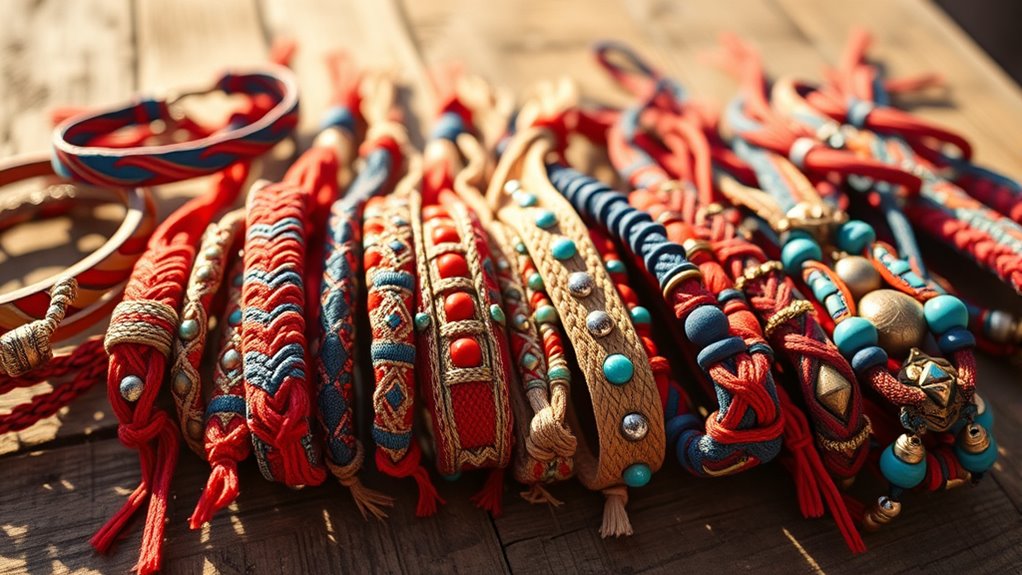
Many ancient cultures developed their own ways of symbolizing friendship through simple, meaningful objects. During ancient trade routes, people exchanged tokens that represented bonds and alliances, helping to solidify relationships across distant lands. These exchanges often carried symbolic significance, rooted in mythical stories that explained the origins of friendship and loyalty. For example, some cultures believed certain charms or cords held mystical powers, protecting friends and strengthening their connection. These traditions show that even in early history, people understood the importance of expressing friendship through tangible symbols. Over time, these objects evolved into more intricate designs, laying the foundation for the friendship bracelets you wear today. Their roots in ancient trade and mythology highlight their deep cultural significance. Additionally, mythology and symbolism played a crucial role in shaping the meanings behind these tokens, imbuing them with cultural stories and spiritual significance. The transmission of these traditions across regions helped preserve their cultural importance, and the use of symbolic objects continues to be a meaningful way to express friendship across cultures and generations.
Cultural Significance Across Continents
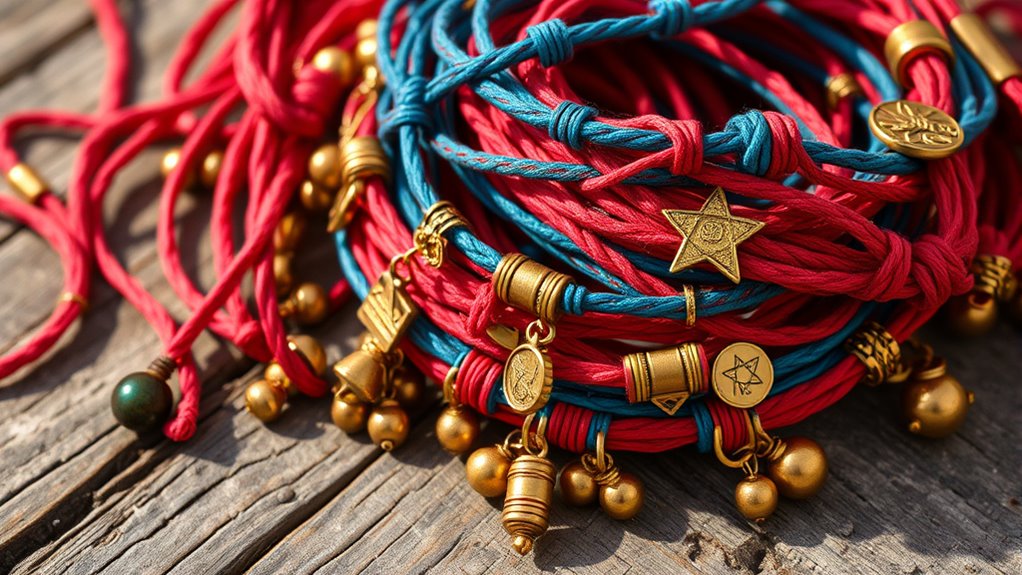
Across different continents, friendship bracelets carry unique symbolism and traditions that reflect local values. You’ll notice how regional craftsmanship and materials influence their design, making each piece culturally meaningful. Exploring these variations reveals how deeply woven these bracelets are into diverse social practices worldwide. For example, some regions incorporate specific cultural symbols into their designs to signify unity and friendship. Additionally, the choice of materials used in bracelet creation can denote particular meanings or social statuses within certain communities. The craftsmanship involved often highlights traditional techniques passed down through generations, further enriching their cultural significance.
Symbolism and Traditions
Friendship bracelets carry deep meanings that vary widely from one culture to another, often symbolizing bonds, loyalty, or good fortune. You’ll find that color symbolism plays a significant role, with certain hues representing love, trust, or protection. For example, red might signify passion, while blue stands for peace. Gift giving customs also influence their significance; offering a bracelet can express gratitude, friendship, or a promise to stay connected. In some cultures, the act of tying a bracelet is a ritual that deepens relationships and marks important milestones. These traditions reflect the values and beliefs of each community, making each bracelet more than just a decorative item — it’s a meaningful token of connection and shared history. Additionally, understanding contrast ratio helps appreciate how visual clarity enhances the beauty and significance of these symbols when displayed or worn. Recognizing the cultural significance of colors and patterns enriches our appreciation of these heartfelt tokens, emphasizing the importance of design elements in conveying deeper meanings.
Regional Craftsmanship and Materials
Regional craftsmanship and materials shape the unique identity of friendship bracelets around the world, reflecting local resources, techniques, and cultural values. You’ll notice that regional artisanship influences the design styles, from intricate knotting patterns to colorful beadwork. Material diversity plays a vital role, as different regions utilize available resources like cotton, hemp, silk, or beads made from shells, stones, or glass. These choices not only define the aesthetic but also carry cultural significance, representing local traditions, beliefs, and environments. In some areas, handmade bracelets become symbols of community and identity, showcasing the skill and artistry passed through generations. Incorporating textile art techniques is also common in crafting these bracelets, enhancing their visual appeal and cultural meaning. Regional variations are further influenced by the regional climate, which affects the durability and types of materials used. By understanding these regional variations, you gain deeper insight into how craftsmanship and material choices forge meaningful connections across cultures through friendship bracelets.
Crafting Techniques and Materials
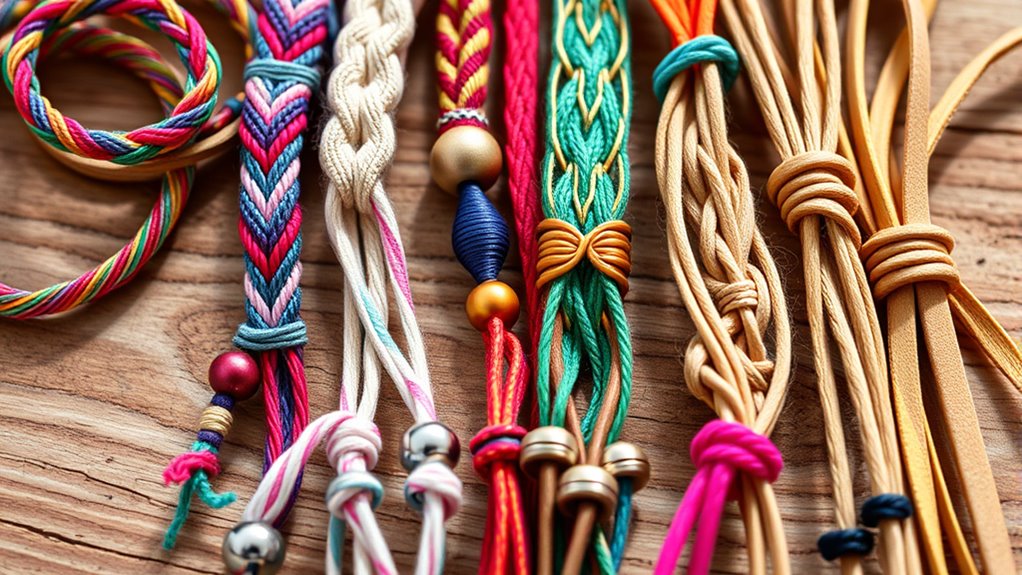
To create vibrant and durable friendship bracelets, you need to understand the essential crafting techniques and materials involved. Mastering beading patterns allows you to design intricate, eye-catching designs, while knotting techniques ensure your bracelet stays secure and lasts over time. The quality of materials, like strong threads and colorful beads, directly influences the final product’s appearance and durability. Using the right materials can also affect how well your bracelet withstands daily wear and tear. Embracing a growth mindset can help you improve your crafting skills through perseverance and learning from challenges. Additionally, understanding skin protection measures ensures that your skin remains healthy during prolonged crafting sessions or outdoor work.
The Rise of Friendship Bracelets in Modern Times
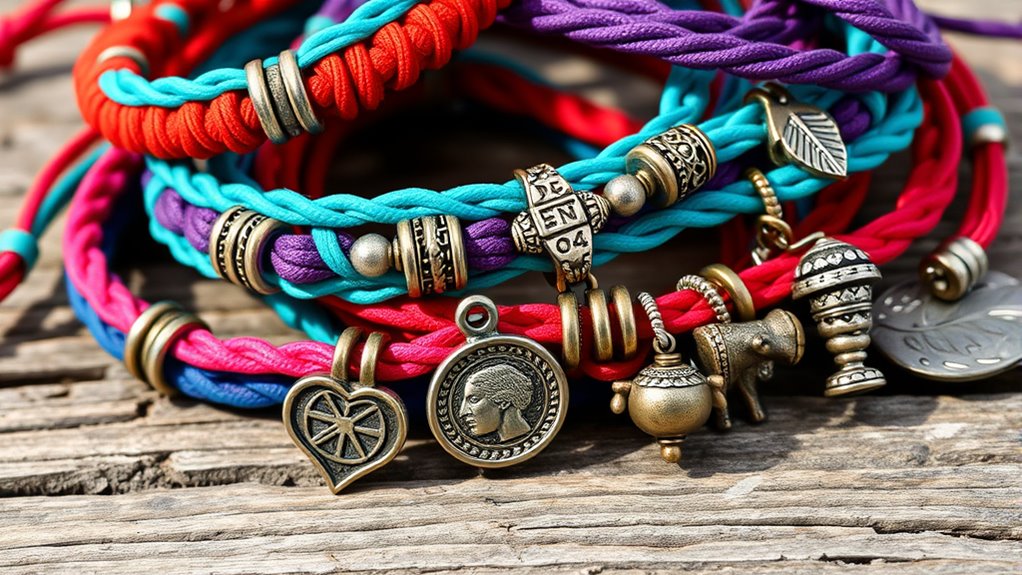
You’ve probably noticed friendship bracelets becoming more popular thanks to social media and DIY trends. Celebrities often showcase their favorite styles, boosting their popularity even more. These influences make it easier than ever for you to create or find the perfect bracelet today. Additionally, the intricate Victoriana-inspired designs often feature elements like gears and mechanical motifs that add a unique, vintage charm to modern accessories. As awareness of father-daughter bonds grows, more personalized and meaningful designs are being crafted to celebrate these special relationships. Incorporating customized cookie preferences into the design process can also make these bracelets even more special for the wearer.
Social Media Influence
Have social media platforms fueled the recent surge in friendship bracelet popularity? Absolutely. Viral challenges encourage users to create and share their unique designs, spreading awareness quickly. Influencer collaborations play a key role, as popular figures showcase their bracelets, inspiring followers to try making their own. This digital exposure transforms friendship bracelets from simple accessories into trendy symbols of connection. Additionally, social media fosters a sense of community, where people share stories behind their bracelets, deepening their significance. The use of social media influence systems and decorative hooks in home decor also enhances personal spaces, reflecting individual style and creativity.
DIY Craft Trends
In recent years, DIY craft trends have propelled friendship bracelets back into the spotlight, making them a popular choice for creative expression. Urban craft workshops now emphasize eco-friendly dyes, allowing you to create sustainable, vibrant accessories. These trends foster community bonding and personal artistry, encouraging you to design unique pieces. By choosing natural dyes and local workshops, you support environmental and social initiatives. Incorporating glycolic acid products into skincare routines exemplifies the trend of blending traditional practices with modern sustainability. Additionally, the resurgence of these crafts highlights a broader movement toward sustainable fashion, promoting eco-conscious materials and ethical production methods. Recognizing the influence of AI security innovations can also inspire new, tech-integrated craft techniques.
Celebrity Endorsements
How have celebrity endorsements propelled friendship bracelets from casual accessories to mainstream fashion statements? When celebrities participate in collaborations or endorse brands, they elevate friendship bracelets to a new level of visibility. Their influence sparks trends, making these accessories desirable beyond friendship symbols. Brand endorsements by popular figures create a sense of exclusivity and style, encouraging fans to emulate their favorite stars. Celebrity collaborations often feature limited-edition designs, boosting their appeal and perceived value. These endorsements help transform friendship bracelets into versatile fashion items, blending personal meaning with trendy aesthetics. The popularity of personalized care and the integration of technology in fashion have further enhanced their appeal, making them a staple in contemporary accessories. Additionally, the growth of social media has amplified the reach of these trends, allowing celebrity styles to influence millions worldwide. As a result, what was once a simple craft now appears in runways and social media feeds, proving that celebrity power can turn a humble accessory into a cultural icon.
Symbolism and Personalization
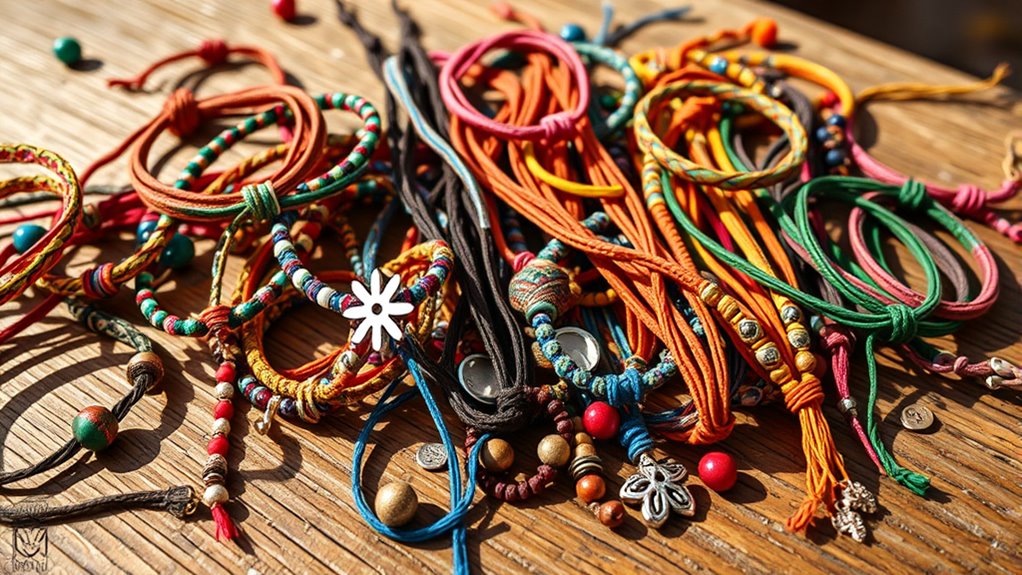
Friendship bracelets often carry deep symbolism and can be personalized to reflect the bond between friends. You might choose specific colors based on meaning, like red for passion or blue for trust, illustrating color symbolism. Personalization techniques include adding charms, initials, or unique patterns that represent shared memories. These details make each bracelet unique and meaningful. To deepen the understanding, consider this table:
| Symbolism/Technique | Meaning/Use |
|---|---|
| Color symbolism | Represents emotions or qualities like loyalty or love |
| Charms | Signify shared experiences or inside jokes |
| Initials | Personalizes the bracelet to the wearer or friend |
| Pattern choices | Convey specific messages or symbolize bonds |
| Material selection | Reflects durability or significance of friendship |
Contemporary Trends and Global Influence
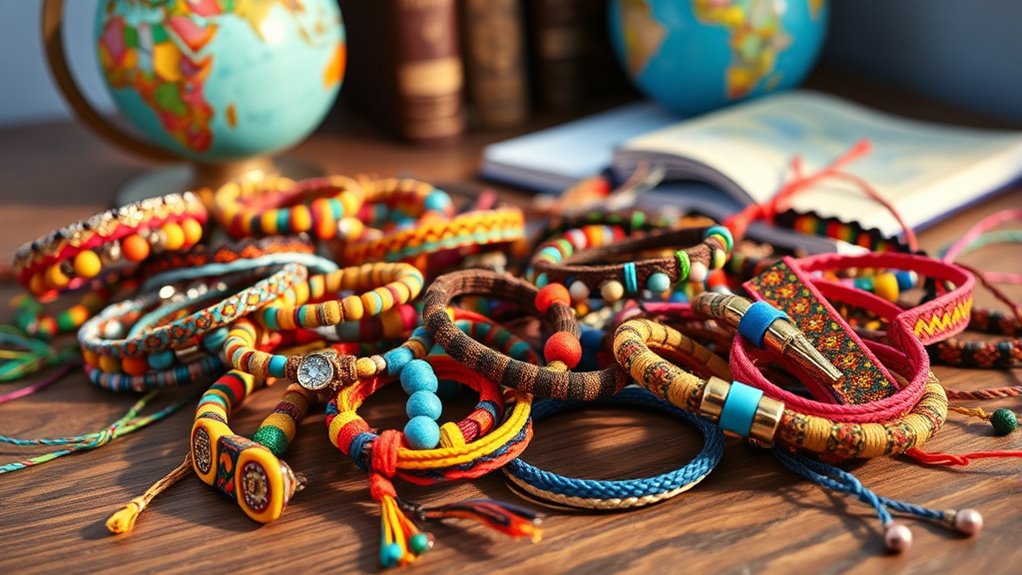
Contemporary trends have transformed friendship bracelets into versatile accessories that reflect diverse cultural influences and modern aesthetics. You now see these bracelets in high-fashion collaborations, blending traditional techniques with luxury brands, making them trendy and meaningful. Many designers emphasize sustainable materials, such as recycled threads and eco-friendly dyes, aligning fashion with environmental consciousness. This shift encourages you to choose bracelets that are not only stylish but also ethically made.
- Embracing sustainable materials deepens your connection to responsible fashion.
- Fashion collaborations highlight how friendship bracelets adapt to current trends.
- Modern designs symbolize a fusion of cultural diversity and personal expression.
Frequently Asked Questions
How Did Friendship Bracelets Originate in Ancient Trade Routes?
You might wonder how friendship bracelets started on ancient trade routes. As traders traveled along these routes, they exchanged goods and ideas, fostering cultural exchange. People began creating and sharing woven or knotted bracelets as tokens of friendship and trust. These small, meaningful items traveled far, symbolizing bonds beyond borders. Over time, this tradition evolved, spreading across cultures and becoming a universal symbol of friendship worldwide.
Are There Specific Colors Linked to Different Meanings Worldwide?
Colors in friendship bracelets serve as silent storytellers, revealing cultural symbolism and tapping into color psychology. You might wear red to symbolize love, blue for trust, or yellow for friendship and happiness. These colors carry specific meanings worldwide, acting as a universal language that transcends borders. Think of them as a vibrant palette of emotions, allowing you to communicate feelings without words, making each bracelet uniquely personal yet universally understood.
What Are the Most Traditional Materials Used in Early Bracelet Making?
You’ll find that traditional friendship bracelets often use materials like cotton, embroidery floss, or wool, which are easy to weave and durable. These materials showcase unique textile patterns that reflect cultural symbolism, representing specific meanings or stories. Historically, artisans chose these natural fibers because they’re accessible, versatile, and hold cultural significance, allowing people to create meaningful designs that connect them to their traditions and communities.
How Do Friendship Bracelets Influence Modern Youth Culture?
Did you know that over 60% of teenagers wear friendship bracelets to express their youth identity? These bracelets serve as symbols of social bonding, helping you connect with friends and showcase your personality. They influence youth culture by promoting creativity, individuality, and shared values. Wearing handmade or trendy designs, you participate in a global movement that strengthens friendships and reflects your place within your peer group.
Can Friendship Bracelets Be Used to Signify Different Types of Relationships?
You can definitely use friendship bracelets to signify different relationships. The significance of colors and cultural symbolism play a key role; for example, red might represent love, while blue symbolizes trust. You choose specific patterns or colors to show close friendship, romantic interest, or family bonds. By customizing the bracelet, you communicate your feelings, making it a meaningful way to distinguish and celebrate various types of relationships.
Conclusion
Friendship bracelets are like colorful threads woven through history, connecting people across cultures and eras. As you wear or craft one, you become part of a vibrant tapestry of traditions and stories. These bracelets are more than just accessories—they’re symbols of bonds that stretch beyond time and borders. So, next time you tie one on, remember you’re adding your own unique thread to this beautiful, ever-growing fabric of friendship.









